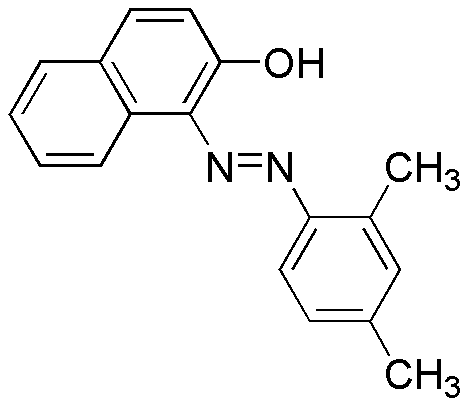Sudan II is widely utilized in research focused on:
- Dyeing and Pigmentation: Commonly used in the textile industry, Sudan II provides vibrant red coloring for fabrics, enhancing aesthetic appeal and marketability.
- Biological Research: Employed as a staining agent in microscopy, it helps researchers visualize cellular structures, making it easier to study biological processes.
- Food Industry Applications: Although banned in many countries due to safety concerns, it has been historically used to color food products, prompting ongoing research into safer alternatives.
- Analytical Chemistry: Utilized in various assays to detect and quantify specific compounds, aiding in quality control and compliance testing in manufacturing.
- Environmental Monitoring: Sudan II is studied for its environmental impact, particularly in assessing contamination levels in water and soil, which is crucial for public health and safety.
General Information
Properties
Safety and Regulations
Applications
Sudan II is widely utilized in research focused on:
- Dyeing and Pigmentation: Commonly used in the textile industry, Sudan II provides vibrant red coloring for fabrics, enhancing aesthetic appeal and marketability.
- Biological Research: Employed as a staining agent in microscopy, it helps researchers visualize cellular structures, making it easier to study biological processes.
- Food Industry Applications: Although banned in many countries due to safety concerns, it has been historically used to color food products, prompting ongoing research into safer alternatives.
- Analytical Chemistry: Utilized in various assays to detect and quantify specific compounds, aiding in quality control and compliance testing in manufacturing.
- Environmental Monitoring: Sudan II is studied for its environmental impact, particularly in assessing contamination levels in water and soil, which is crucial for public health and safety.
Documents
Safety Data Sheets (SDS)
The SDS provides comprehensive safety information on handling, storage, and disposal of the product.
Product Specification (PS)
The PS provides a comprehensive breakdown of the product’s properties, including chemical composition, physical state, purity, and storage requirements. It also details acceptable quality ranges and the product's intended applications.
Certificates of Analysis (COA)
Search for Certificates of Analysis (COA) by entering the products Lot Number. Lot and Batch Numbers can be found on a product’s label following the words ‘Lot’ or ‘Batch’.
*Catalog Number
*Lot Number
Certificates Of Origin (COO)
This COO confirms the country where the product was manufactured, and also details the materials and components used in it and whether it is derived from natural, synthetic, or other specific sources. This certificate may be required for customs, trade, and regulatory compliance.
*Catalog Number
*Lot Number
Safety Data Sheets (SDS)
The SDS provides comprehensive safety information on handling, storage, and disposal of the product.
DownloadProduct Specification (PS)
The PS provides a comprehensive breakdown of the product’s properties, including chemical composition, physical state, purity, and storage requirements. It also details acceptable quality ranges and the product's intended applications.
DownloadCertificates of Analysis (COA)
Search for Certificates of Analysis (COA) by entering the products Lot Number. Lot and Batch Numbers can be found on a product’s label following the words ‘Lot’ or ‘Batch’.
*Catalog Number
*Lot Number
Certificates Of Origin (COO)
This COO confirms the country where the product was manufactured, and also details the materials and components used in it and whether it is derived from natural, synthetic, or other specific sources. This certificate may be required for customs, trade, and regulatory compliance.


